Leadership and Management Strategies for Service Industries Report
VerifiedAdded on 2020/12/29
|9
|2075
|500
Report
AI Summary
This report examines leadership and management principles within the service industry, focusing on the application of classical management theories and various leadership styles, including autocratic, democratic, and free-rein approaches. It analyzes the role of leaders in initiating action, building confidence, and guiding employees, while also reviewing the effectiveness of different management and leadership styles in a service context. The report explores the internal and external factors influencing management style and structure, utilizing SWOT and PESTLE analyses to assess strengths, weaknesses, opportunities, threats, political, economic, social, technological, legal, and environmental factors. Furthermore, it highlights the significance of transformational/charismatic leadership and conceptual management skills in achieving successful business objectives within the service sector, and how they can be used to overcome challenges and drive growth.
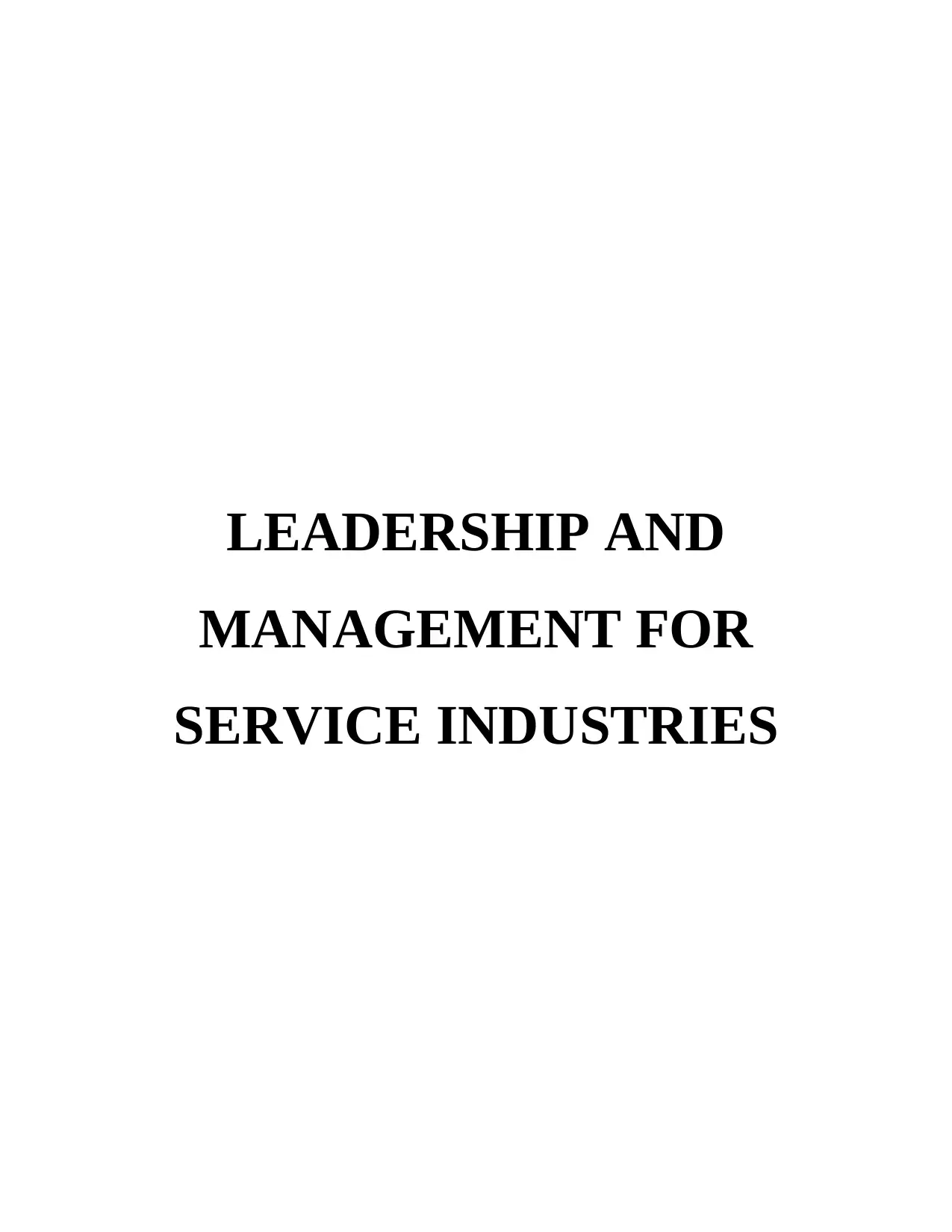
LEADERSHIP AND
MANAGEMENT FOR
SERVICE INDUSTRIES
MANAGEMENT FOR
SERVICE INDUSTRIES
Paraphrase This Document
Need a fresh take? Get an instant paraphrase of this document with our AI Paraphraser
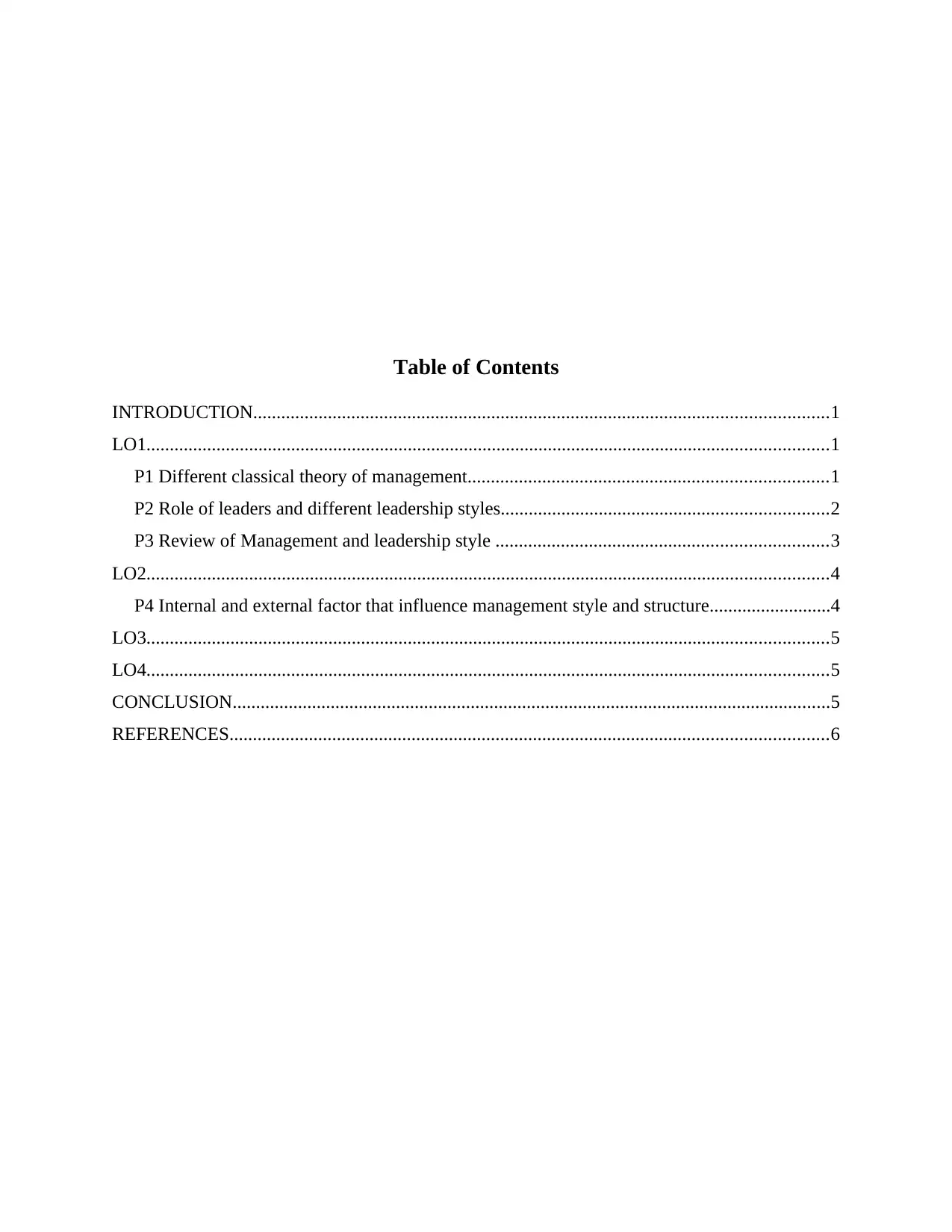
Table of Contents
INTRODUCTION...........................................................................................................................1
LO1..................................................................................................................................................1
P1 Different classical theory of management.............................................................................1
P2 Role of leaders and different leadership styles......................................................................2
P3 Review of Management and leadership style .......................................................................3
LO2..................................................................................................................................................4
P4 Internal and external factor that influence management style and structure..........................4
LO3..................................................................................................................................................5
LO4..................................................................................................................................................5
CONCLUSION................................................................................................................................5
REFERENCES................................................................................................................................6
INTRODUCTION...........................................................................................................................1
LO1..................................................................................................................................................1
P1 Different classical theory of management.............................................................................1
P2 Role of leaders and different leadership styles......................................................................2
P3 Review of Management and leadership style .......................................................................3
LO2..................................................................................................................................................4
P4 Internal and external factor that influence management style and structure..........................4
LO3..................................................................................................................................................5
LO4..................................................................................................................................................5
CONCLUSION................................................................................................................................5
REFERENCES................................................................................................................................6

⊘ This is a preview!⊘
Do you want full access?
Subscribe today to unlock all pages.

Trusted by 1+ million students worldwide
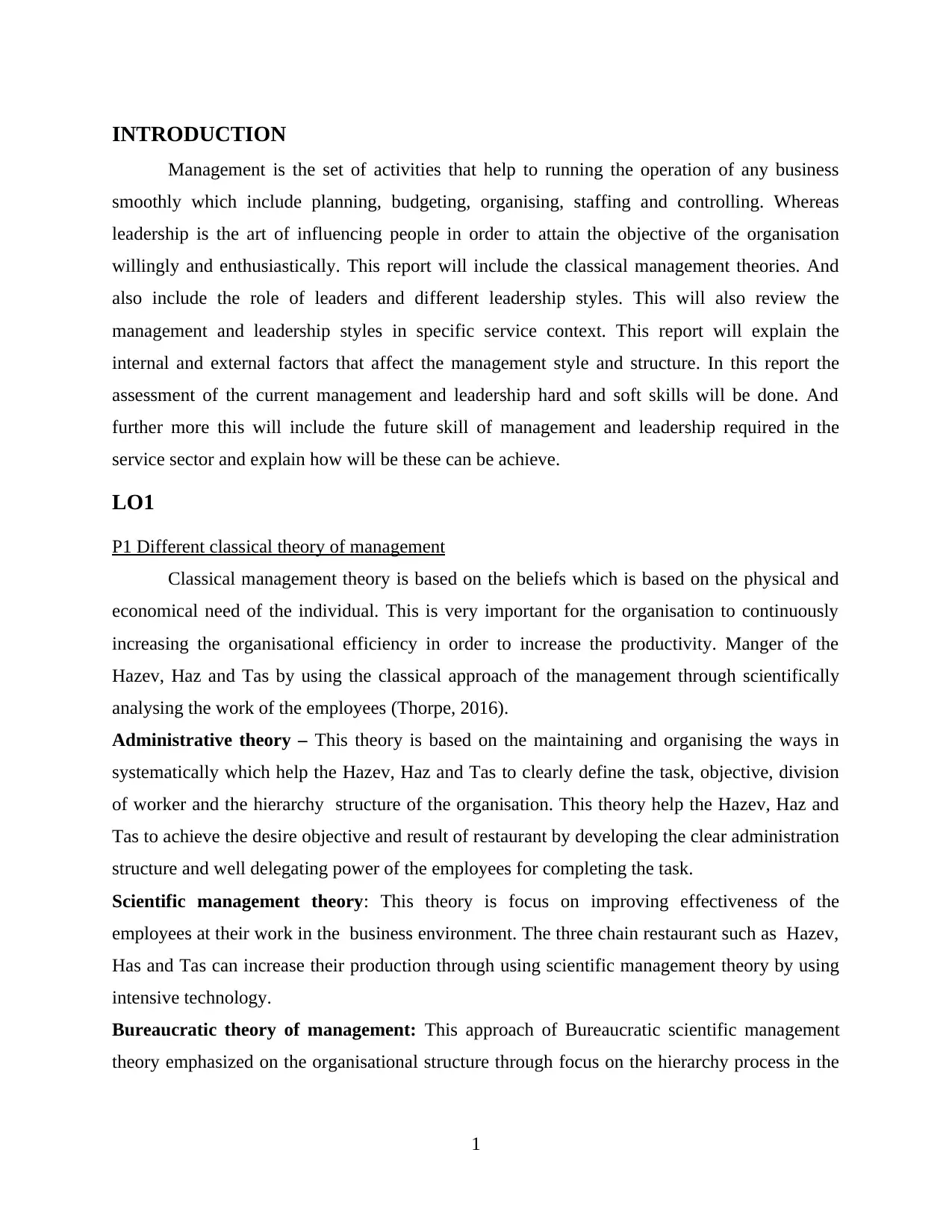
INTRODUCTION
Management is the set of activities that help to running the operation of any business
smoothly which include planning, budgeting, organising, staffing and controlling. Whereas
leadership is the art of influencing people in order to attain the objective of the organisation
willingly and enthusiastically. This report will include the classical management theories. And
also include the role of leaders and different leadership styles. This will also review the
management and leadership styles in specific service context. This report will explain the
internal and external factors that affect the management style and structure. In this report the
assessment of the current management and leadership hard and soft skills will be done. And
further more this will include the future skill of management and leadership required in the
service sector and explain how will be these can be achieve.
LO1
P1 Different classical theory of management
Classical management theory is based on the beliefs which is based on the physical and
economical need of the individual. This is very important for the organisation to continuously
increasing the organisational efficiency in order to increase the productivity. Manger of the
Hazev, Haz and Tas by using the classical approach of the management through scientifically
analysing the work of the employees (Thorpe, 2016).
Administrative theory – This theory is based on the maintaining and organising the ways in
systematically which help the Hazev, Haz and Tas to clearly define the task, objective, division
of worker and the hierarchy structure of the organisation. This theory help the Hazev, Haz and
Tas to achieve the desire objective and result of restaurant by developing the clear administration
structure and well delegating power of the employees for completing the task.
Scientific management theory: This theory is focus on improving effectiveness of the
employees at their work in the business environment. The three chain restaurant such as Hazev,
Has and Tas can increase their production through using scientific management theory by using
intensive technology.
Bureaucratic theory of management: This approach of Bureaucratic scientific management
theory emphasized on the organisational structure through focus on the hierarchy process in the
1
Management is the set of activities that help to running the operation of any business
smoothly which include planning, budgeting, organising, staffing and controlling. Whereas
leadership is the art of influencing people in order to attain the objective of the organisation
willingly and enthusiastically. This report will include the classical management theories. And
also include the role of leaders and different leadership styles. This will also review the
management and leadership styles in specific service context. This report will explain the
internal and external factors that affect the management style and structure. In this report the
assessment of the current management and leadership hard and soft skills will be done. And
further more this will include the future skill of management and leadership required in the
service sector and explain how will be these can be achieve.
LO1
P1 Different classical theory of management
Classical management theory is based on the beliefs which is based on the physical and
economical need of the individual. This is very important for the organisation to continuously
increasing the organisational efficiency in order to increase the productivity. Manger of the
Hazev, Haz and Tas by using the classical approach of the management through scientifically
analysing the work of the employees (Thorpe, 2016).
Administrative theory – This theory is based on the maintaining and organising the ways in
systematically which help the Hazev, Haz and Tas to clearly define the task, objective, division
of worker and the hierarchy structure of the organisation. This theory help the Hazev, Haz and
Tas to achieve the desire objective and result of restaurant by developing the clear administration
structure and well delegating power of the employees for completing the task.
Scientific management theory: This theory is focus on improving effectiveness of the
employees at their work in the business environment. The three chain restaurant such as Hazev,
Has and Tas can increase their production through using scientific management theory by using
intensive technology.
Bureaucratic theory of management: This approach of Bureaucratic scientific management
theory emphasized on the organisational structure through focus on the hierarchy process in the
1
Paraphrase This Document
Need a fresh take? Get an instant paraphrase of this document with our AI Paraphraser
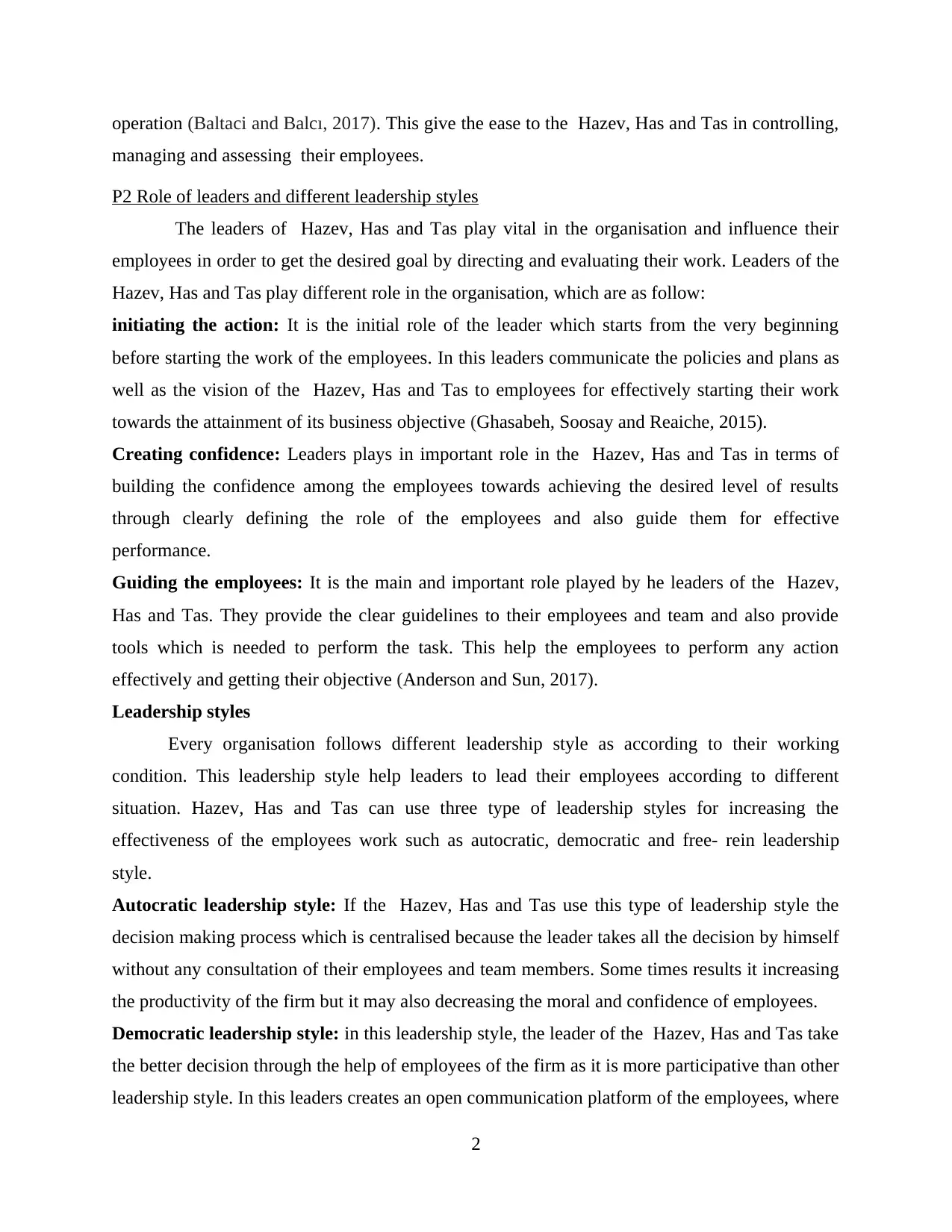
operation (Baltaci and Balcı, 2017). This give the ease to the Hazev, Has and Tas in controlling,
managing and assessing their employees.
P2 Role of leaders and different leadership styles
The leaders of Hazev, Has and Tas play vital in the organisation and influence their
employees in order to get the desired goal by directing and evaluating their work. Leaders of the
Hazev, Has and Tas play different role in the organisation, which are as follow:
initiating the action: It is the initial role of the leader which starts from the very beginning
before starting the work of the employees. In this leaders communicate the policies and plans as
well as the vision of the Hazev, Has and Tas to employees for effectively starting their work
towards the attainment of its business objective (Ghasabeh, Soosay and Reaiche, 2015).
Creating confidence: Leaders plays in important role in the Hazev, Has and Tas in terms of
building the confidence among the employees towards achieving the desired level of results
through clearly defining the role of the employees and also guide them for effective
performance.
Guiding the employees: It is the main and important role played by he leaders of the Hazev,
Has and Tas. They provide the clear guidelines to their employees and team and also provide
tools which is needed to perform the task. This help the employees to perform any action
effectively and getting their objective (Anderson and Sun, 2017).
Leadership styles
Every organisation follows different leadership style as according to their working
condition. This leadership style help leaders to lead their employees according to different
situation. Hazev, Has and Tas can use three type of leadership styles for increasing the
effectiveness of the employees work such as autocratic, democratic and free- rein leadership
style.
Autocratic leadership style: If the Hazev, Has and Tas use this type of leadership style the
decision making process which is centralised because the leader takes all the decision by himself
without any consultation of their employees and team members. Some times results it increasing
the productivity of the firm but it may also decreasing the moral and confidence of employees.
Democratic leadership style: in this leadership style, the leader of the Hazev, Has and Tas take
the better decision through the help of employees of the firm as it is more participative than other
leadership style. In this leaders creates an open communication platform of the employees, where
2
managing and assessing their employees.
P2 Role of leaders and different leadership styles
The leaders of Hazev, Has and Tas play vital in the organisation and influence their
employees in order to get the desired goal by directing and evaluating their work. Leaders of the
Hazev, Has and Tas play different role in the organisation, which are as follow:
initiating the action: It is the initial role of the leader which starts from the very beginning
before starting the work of the employees. In this leaders communicate the policies and plans as
well as the vision of the Hazev, Has and Tas to employees for effectively starting their work
towards the attainment of its business objective (Ghasabeh, Soosay and Reaiche, 2015).
Creating confidence: Leaders plays in important role in the Hazev, Has and Tas in terms of
building the confidence among the employees towards achieving the desired level of results
through clearly defining the role of the employees and also guide them for effective
performance.
Guiding the employees: It is the main and important role played by he leaders of the Hazev,
Has and Tas. They provide the clear guidelines to their employees and team and also provide
tools which is needed to perform the task. This help the employees to perform any action
effectively and getting their objective (Anderson and Sun, 2017).
Leadership styles
Every organisation follows different leadership style as according to their working
condition. This leadership style help leaders to lead their employees according to different
situation. Hazev, Has and Tas can use three type of leadership styles for increasing the
effectiveness of the employees work such as autocratic, democratic and free- rein leadership
style.
Autocratic leadership style: If the Hazev, Has and Tas use this type of leadership style the
decision making process which is centralised because the leader takes all the decision by himself
without any consultation of their employees and team members. Some times results it increasing
the productivity of the firm but it may also decreasing the moral and confidence of employees.
Democratic leadership style: in this leadership style, the leader of the Hazev, Has and Tas take
the better decision through the help of employees of the firm as it is more participative than other
leadership style. In this leaders creates an open communication platform of the employees, where
2
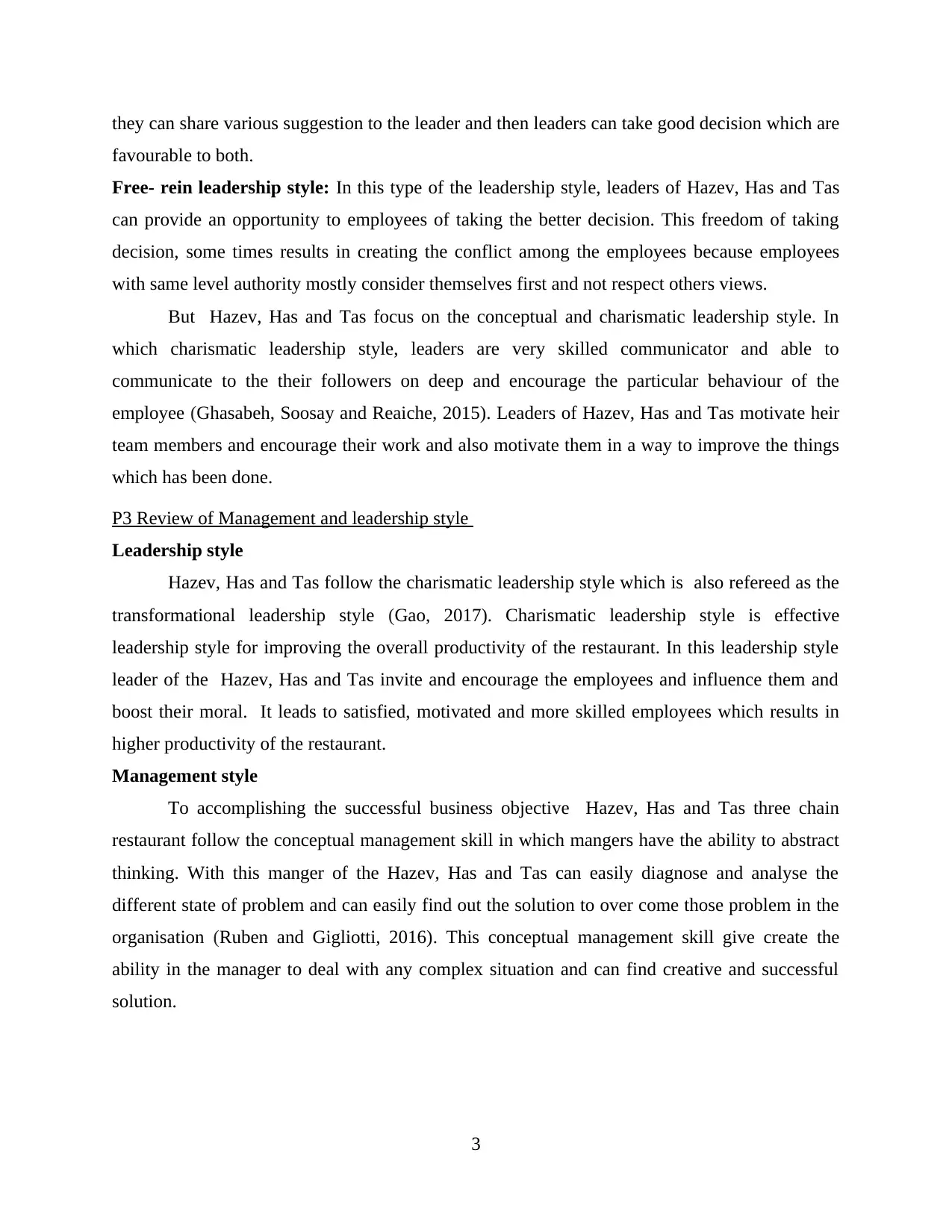
they can share various suggestion to the leader and then leaders can take good decision which are
favourable to both.
Free- rein leadership style: In this type of the leadership style, leaders of Hazev, Has and Tas
can provide an opportunity to employees of taking the better decision. This freedom of taking
decision, some times results in creating the conflict among the employees because employees
with same level authority mostly consider themselves first and not respect others views.
But Hazev, Has and Tas focus on the conceptual and charismatic leadership style. In
which charismatic leadership style, leaders are very skilled communicator and able to
communicate to the their followers on deep and encourage the particular behaviour of the
employee (Ghasabeh, Soosay and Reaiche, 2015). Leaders of Hazev, Has and Tas motivate heir
team members and encourage their work and also motivate them in a way to improve the things
which has been done.
P3 Review of Management and leadership style
Leadership style
Hazev, Has and Tas follow the charismatic leadership style which is also refereed as the
transformational leadership style (Gao, 2017). Charismatic leadership style is effective
leadership style for improving the overall productivity of the restaurant. In this leadership style
leader of the Hazev, Has and Tas invite and encourage the employees and influence them and
boost their moral. It leads to satisfied, motivated and more skilled employees which results in
higher productivity of the restaurant.
Management style
To accomplishing the successful business objective Hazev, Has and Tas three chain
restaurant follow the conceptual management skill in which mangers have the ability to abstract
thinking. With this manger of the Hazev, Has and Tas can easily diagnose and analyse the
different state of problem and can easily find out the solution to over come those problem in the
organisation (Ruben and Gigliotti, 2016). This conceptual management skill give create the
ability in the manager to deal with any complex situation and can find creative and successful
solution.
3
favourable to both.
Free- rein leadership style: In this type of the leadership style, leaders of Hazev, Has and Tas
can provide an opportunity to employees of taking the better decision. This freedom of taking
decision, some times results in creating the conflict among the employees because employees
with same level authority mostly consider themselves first and not respect others views.
But Hazev, Has and Tas focus on the conceptual and charismatic leadership style. In
which charismatic leadership style, leaders are very skilled communicator and able to
communicate to the their followers on deep and encourage the particular behaviour of the
employee (Ghasabeh, Soosay and Reaiche, 2015). Leaders of Hazev, Has and Tas motivate heir
team members and encourage their work and also motivate them in a way to improve the things
which has been done.
P3 Review of Management and leadership style
Leadership style
Hazev, Has and Tas follow the charismatic leadership style which is also refereed as the
transformational leadership style (Gao, 2017). Charismatic leadership style is effective
leadership style for improving the overall productivity of the restaurant. In this leadership style
leader of the Hazev, Has and Tas invite and encourage the employees and influence them and
boost their moral. It leads to satisfied, motivated and more skilled employees which results in
higher productivity of the restaurant.
Management style
To accomplishing the successful business objective Hazev, Has and Tas three chain
restaurant follow the conceptual management skill in which mangers have the ability to abstract
thinking. With this manger of the Hazev, Has and Tas can easily diagnose and analyse the
different state of problem and can easily find out the solution to over come those problem in the
organisation (Ruben and Gigliotti, 2016). This conceptual management skill give create the
ability in the manager to deal with any complex situation and can find creative and successful
solution.
3
⊘ This is a preview!⊘
Do you want full access?
Subscribe today to unlock all pages.

Trusted by 1+ million students worldwide
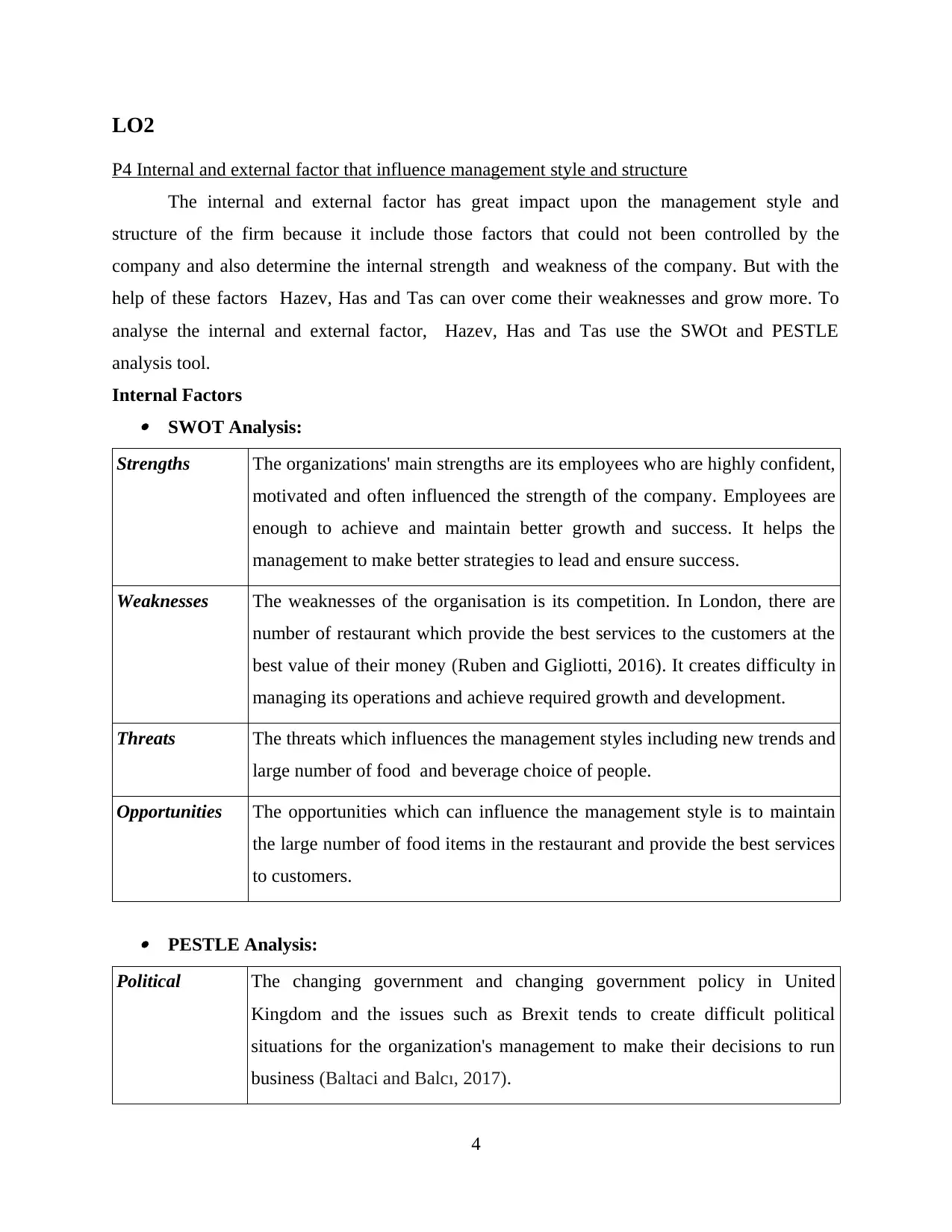
LO2
P4 Internal and external factor that influence management style and structure
The internal and external factor has great impact upon the management style and
structure of the firm because it include those factors that could not been controlled by the
company and also determine the internal strength and weakness of the company. But with the
help of these factors Hazev, Has and Tas can over come their weaknesses and grow more. To
analyse the internal and external factor, Hazev, Has and Tas use the SWOt and PESTLE
analysis tool.
Internal Factors SWOT Analysis:
Strengths The organizations' main strengths are its employees who are highly confident,
motivated and often influenced the strength of the company. Employees are
enough to achieve and maintain better growth and success. It helps the
management to make better strategies to lead and ensure success.
Weaknesses The weaknesses of the organisation is its competition. In London, there are
number of restaurant which provide the best services to the customers at the
best value of their money (Ruben and Gigliotti, 2016). It creates difficulty in
managing its operations and achieve required growth and development.
Threats The threats which influences the management styles including new trends and
large number of food and beverage choice of people.
Opportunities The opportunities which can influence the management style is to maintain
the large number of food items in the restaurant and provide the best services
to customers.
PESTLE Analysis:
Political The changing government and changing government policy in United
Kingdom and the issues such as Brexit tends to create difficult political
situations for the organization's management to make their decisions to run
business (Baltaci and Balcı, 2017).
4
P4 Internal and external factor that influence management style and structure
The internal and external factor has great impact upon the management style and
structure of the firm because it include those factors that could not been controlled by the
company and also determine the internal strength and weakness of the company. But with the
help of these factors Hazev, Has and Tas can over come their weaknesses and grow more. To
analyse the internal and external factor, Hazev, Has and Tas use the SWOt and PESTLE
analysis tool.
Internal Factors SWOT Analysis:
Strengths The organizations' main strengths are its employees who are highly confident,
motivated and often influenced the strength of the company. Employees are
enough to achieve and maintain better growth and success. It helps the
management to make better strategies to lead and ensure success.
Weaknesses The weaknesses of the organisation is its competition. In London, there are
number of restaurant which provide the best services to the customers at the
best value of their money (Ruben and Gigliotti, 2016). It creates difficulty in
managing its operations and achieve required growth and development.
Threats The threats which influences the management styles including new trends and
large number of food and beverage choice of people.
Opportunities The opportunities which can influence the management style is to maintain
the large number of food items in the restaurant and provide the best services
to customers.
PESTLE Analysis:
Political The changing government and changing government policy in United
Kingdom and the issues such as Brexit tends to create difficult political
situations for the organization's management to make their decisions to run
business (Baltaci and Balcı, 2017).
4
Paraphrase This Document
Need a fresh take? Get an instant paraphrase of this document with our AI Paraphraser
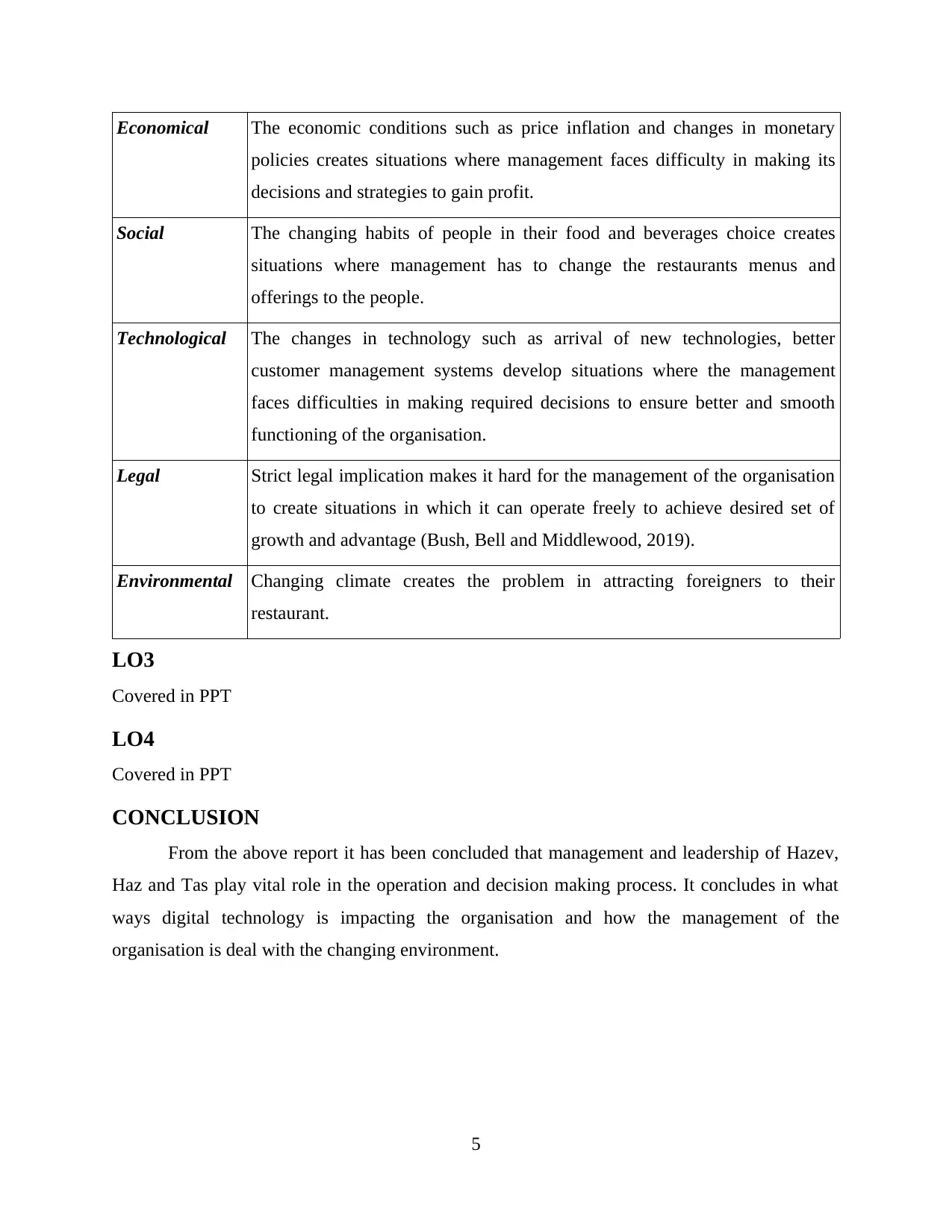
Economical The economic conditions such as price inflation and changes in monetary
policies creates situations where management faces difficulty in making its
decisions and strategies to gain profit.
Social The changing habits of people in their food and beverages choice creates
situations where management has to change the restaurants menus and
offerings to the people.
Technological The changes in technology such as arrival of new technologies, better
customer management systems develop situations where the management
faces difficulties in making required decisions to ensure better and smooth
functioning of the organisation.
Legal Strict legal implication makes it hard for the management of the organisation
to create situations in which it can operate freely to achieve desired set of
growth and advantage (Bush, Bell and Middlewood, 2019).
Environmental Changing climate creates the problem in attracting foreigners to their
restaurant.
LO3
Covered in PPT
LO4
Covered in PPT
CONCLUSION
From the above report it has been concluded that management and leadership of Hazev,
Haz and Tas play vital role in the operation and decision making process. It concludes in what
ways digital technology is impacting the organisation and how the management of the
organisation is deal with the changing environment.
5
policies creates situations where management faces difficulty in making its
decisions and strategies to gain profit.
Social The changing habits of people in their food and beverages choice creates
situations where management has to change the restaurants menus and
offerings to the people.
Technological The changes in technology such as arrival of new technologies, better
customer management systems develop situations where the management
faces difficulties in making required decisions to ensure better and smooth
functioning of the organisation.
Legal Strict legal implication makes it hard for the management of the organisation
to create situations in which it can operate freely to achieve desired set of
growth and advantage (Bush, Bell and Middlewood, 2019).
Environmental Changing climate creates the problem in attracting foreigners to their
restaurant.
LO3
Covered in PPT
LO4
Covered in PPT
CONCLUSION
From the above report it has been concluded that management and leadership of Hazev,
Haz and Tas play vital role in the operation and decision making process. It concludes in what
ways digital technology is impacting the organisation and how the management of the
organisation is deal with the changing environment.
5
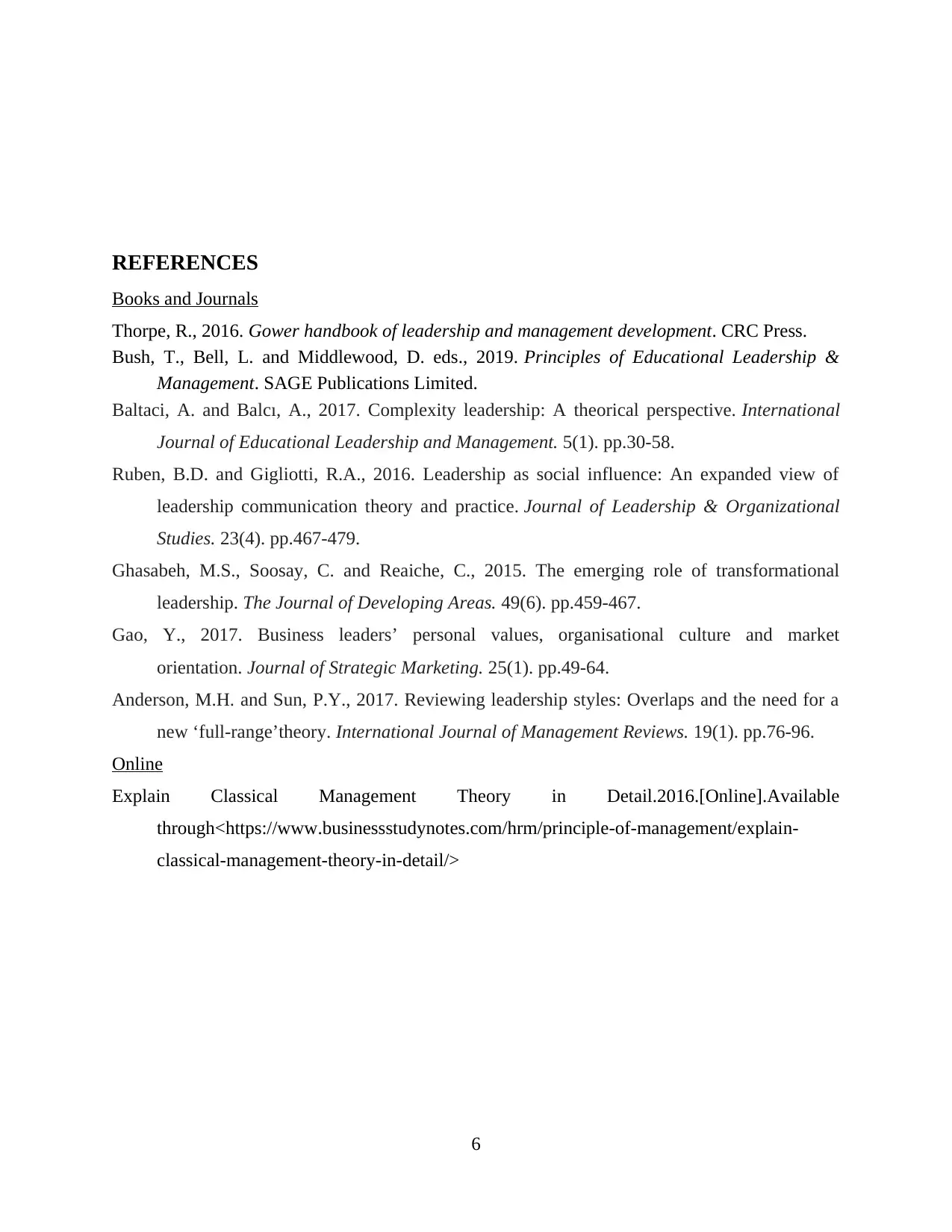
REFERENCES
Books and Journals
Thorpe, R., 2016. Gower handbook of leadership and management development. CRC Press.
Bush, T., Bell, L. and Middlewood, D. eds., 2019. Principles of Educational Leadership &
Management. SAGE Publications Limited.
Baltaci, A. and Balcı, A., 2017. Complexity leadership: A theorical perspective. International
Journal of Educational Leadership and Management. 5(1). pp.30-58.
Ruben, B.D. and Gigliotti, R.A., 2016. Leadership as social influence: An expanded view of
leadership communication theory and practice. Journal of Leadership & Organizational
Studies. 23(4). pp.467-479.
Ghasabeh, M.S., Soosay, C. and Reaiche, C., 2015. The emerging role of transformational
leadership. The Journal of Developing Areas. 49(6). pp.459-467.
Gao, Y., 2017. Business leaders’ personal values, organisational culture and market
orientation. Journal of Strategic Marketing. 25(1). pp.49-64.
Anderson, M.H. and Sun, P.Y., 2017. Reviewing leadership styles: Overlaps and the need for a
new ‘full‐range’theory. International Journal of Management Reviews. 19(1). pp.76-96.
Online
Explain Classical Management Theory in Detail.2016.[Online].Available
through<https://www.businessstudynotes.com/hrm/principle-of-management/explain-
classical-management-theory-in-detail/>
6
Books and Journals
Thorpe, R., 2016. Gower handbook of leadership and management development. CRC Press.
Bush, T., Bell, L. and Middlewood, D. eds., 2019. Principles of Educational Leadership &
Management. SAGE Publications Limited.
Baltaci, A. and Balcı, A., 2017. Complexity leadership: A theorical perspective. International
Journal of Educational Leadership and Management. 5(1). pp.30-58.
Ruben, B.D. and Gigliotti, R.A., 2016. Leadership as social influence: An expanded view of
leadership communication theory and practice. Journal of Leadership & Organizational
Studies. 23(4). pp.467-479.
Ghasabeh, M.S., Soosay, C. and Reaiche, C., 2015. The emerging role of transformational
leadership. The Journal of Developing Areas. 49(6). pp.459-467.
Gao, Y., 2017. Business leaders’ personal values, organisational culture and market
orientation. Journal of Strategic Marketing. 25(1). pp.49-64.
Anderson, M.H. and Sun, P.Y., 2017. Reviewing leadership styles: Overlaps and the need for a
new ‘full‐range’theory. International Journal of Management Reviews. 19(1). pp.76-96.
Online
Explain Classical Management Theory in Detail.2016.[Online].Available
through<https://www.businessstudynotes.com/hrm/principle-of-management/explain-
classical-management-theory-in-detail/>
6
⊘ This is a preview!⊘
Do you want full access?
Subscribe today to unlock all pages.

Trusted by 1+ million students worldwide
1 out of 9
Related Documents
Your All-in-One AI-Powered Toolkit for Academic Success.
+13062052269
info@desklib.com
Available 24*7 on WhatsApp / Email
![[object Object]](/_next/static/media/star-bottom.7253800d.svg)
Unlock your academic potential
Copyright © 2020–2025 A2Z Services. All Rights Reserved. Developed and managed by ZUCOL.





